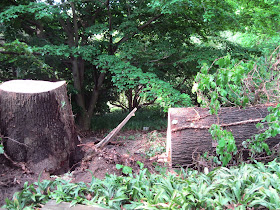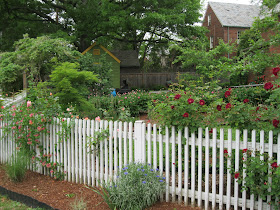







I have admired this garden for some time without really looking at it, but today I stopped on my way to the garage, took the top picture, then went back into the lobby and walked through the garden. I'd just left my father who'd had a combination pacemaker defibrillator implanted. He handled the operation well. He's hanging in there at 81 and was up, talking, and ordering dinner within half an hour of returning to his room. So I left him to my two sisters.
It seems like all hospitals have healing/ meditation gardens and they seem, on the whole, to be pleasant spaces. I imagine it isn't easy to design a tranquil space in the shadow of huge multistoried modern buildings. I really do like this one. I love the plant palette, really love it; it's mostly, but not all native. There are a lot of grasses, Panicums and Prairie Dropseed. And large masses of native shrubs: Calycanthus,
Oakleaf Hydrangea, Leucothoe, ... There are a few very choice small trees: Chionanthus in bloom, Stewartias waiting to flower, and a beautiful Styrax (I think the native one). I love Lady's Mantle massed, as it was here; of course it's best feature is the way the leaves catch raindrops and since it was pouring this evening I saw it at its best.
The fountain runs the length of the garden and provides some of the structure that helps relate the organic component of the garden to the massive structure of the Hospital buildings. The huge trellises work to this end as well; the roses and clematis are wonderfully grown and this was the perfect time of year to see them though there is a Sweet Autumn Clematis that must be spectacular in late August.
If this weren't such a wonderful garden I wouldn't offer any criticism but because it is I'll observe that some of the shrub groupings are planted a bit thickly and the resulting masses feel formless and heavy. Still, the plants are beautiful so perhaps all is good. It is certainly a very good design that has resulted in a very successful garden.

 Today the tree contractors took out the last of the two fallen oaks in the Japanese Woodland.
Today the tree contractors took out the last of the two fallen oaks in the Japanese Woodland.

































